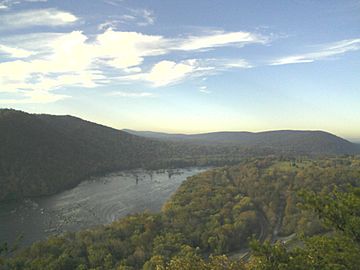Blue Ridge Mountain facts for kids
Quick facts for kids Blue Ridge Mountain |
|
|---|---|

Blue Ridge Mountain as seen from across the Potomac on Weverton Cliffs
|
|
| Highest point | |
| Elevation | 2,388 ft (728 m) |
| Geography | |
| Location | Virginia, West Virginia |
| Parent range | Blue Ridge Mountains |
| Climbing | |
| Easiest route | Hike |
Blue Ridge Mountain, sometimes called Blue Mountain, is a long, narrow mountain ridge. It's the western edge of the larger Blue Ridge Mountains range. You can find it in northern Virginia and the eastern part of West Virginia. A famous hiking path, the Appalachian Trail, runs right along this mountain, following its western side and top.
Contents
Where is Blue Ridge Mountain?
This mountain stretches from the Potomac River in the north down to Chester Gap in the south. In this area, Blue Ridge Mountain is mostly a single ridge. It doesn't have many smaller ridges or peaks branching off.
A few other mountains are nearby. The Bull Run and Catoctin mountains are about 32 kilometers (20 miles) to the east. They are across the Loudoun Valley. Also, Short Hill Mountain is about 6.4 kilometers (4 miles) east. It runs next to the Blue Ridge for about 19 kilometers (12 miles) near the northern end. To the west of Blue Ridge Mountain is the lower Shenandoah Valley.
How Tall is the Mountain?
Blue Ridge Mountain is not as tall as some other parts of the Blue Ridge Mountains in Virginia. The southern part of the mountain has the highest peaks. As you go north towards the Potomac River, the mountain gets lower.
The low spots, called "gaps," are usually around 300 meters (1,000 feet) high. The peaks can range from 365 meters (1,200 feet) to 700 meters (2,300 feet) tall. Across the Potomac River, the ridge continues into Maryland as Elk Ridge.
Mountain Borders
The top of the mountain forms the border between several counties. On the east side are Loudoun County and Fauquier County, both in Virginia. On the west side are Jefferson County, West Virginia, Clarke County, Virginia, and Warren County, Virginia.
What is Blue Ridge Mountain Made Of?
Blue Ridge Mountain is mostly made of a type of rock called Catoctin Greenstone. This rock formed a long time ago. It was pushed up during a major event called the Alleghenian Orogeny. This event created many mountains. Because of this type of rock, the mountain looks more like a long ridge and is not as rough as some other parts of the Blue Ridge Mountains.
Fun Things to Do
Blue Ridge Mountain has several parks and areas where you can enjoy nature and outdoor activities. These include:
- Harpers Ferry National Historical Park: A place with lots of history and beautiful views.
- Rolling Ridge Foundation: A private area for nature and learning.
- Sky Meadows State Park: A state park great for hiking and picnics.
- G. Richard Thompson Wildlife Management Area: A place for wildlife and outdoor recreation.
Important Peaks
Here are some of the notable peaks on Blue Ridge Mountain, listed from north to south:
- Loudoun Heights
- Purcell Knob
- Raven Rocks
- Mount Weather
- Paris Mountain
Important Gaps
These are some of the notable low spots or "gaps" on Blue Ridge Mountain, listed from north to south:

